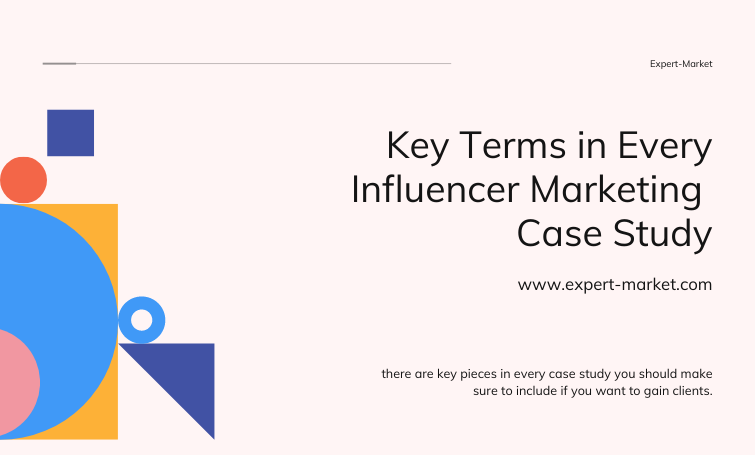Influencer marketing case studies are crucial pieces of content for influencer marketing agencies to promote their services and attract new clients. As social media continues to grow and advance, more brands are looking to spend their marketing dollars and invest in influencer marketing. The power of influencers on social media is strong, and traditional media methods aren’t proving to be as effective.
With this in mind, brands and marketing agencies turn to influencer marketing case studies to set themselves as authorities in their industry by showing they have what it takes to run a successful campaign on social media. Now that you know how important influencer marketing case studies are, it’s time you know all of the terms and information you need to read them correctly.
Important Pieces in Influencer Marketing Case Studies
There’s no one right way to create influencer marketing case studies. Many brands and agencies put together stellar case studies although they put them together in different ways. For example, one brand may choose to publish their case study as a blog post on their website while another may decide to film a video to post on their YouTube channel. No matter which medium you choose, there are key pieces in every case study you should make sure to include if you want to gain clients.

ROI:
One of the most important terms you’ll hear in the marketing space is ROI or Return on Investment. Basically, this metric refers to how effective your marketing investments into your business are at generating income, which is helpful when comparing gains and losses.
Strategy:
When it comes to influencer marketing case studies, outlining your strategy is key. If your campaign became a hit on social media, potential new clients want to know how you did it. You’ll want to be sure to discuss both your creative strategy for content and any data-backed strategy you use to measure performance or source influencers.
Creative Direction:
Before a brand goes to work with an influencer marketing agency, they’ll typically have set expectations, a vision, and campaign goals. Together, the brand and an agency will brainstorm creative strategies and content ideas based on the product and brand’s image and values. For example, a toy company may decide to have kid-friendly TikTok influencer film unboxing content using an original song with their new product.
Influencer Roster:
Once you’ve found the direction you want to go in terms of creative strategy, building an influencer roster is the next step. A roster should tell the brand who the influencer is and why they would be great for the campaign, link to their accounts, and show their reach on their various social media channels. After the roster is built based on who would best match the campaign, then the brand should then go through the roster and pick out the creators they want to partner with.
Activation:
After the roster is finalized, a brand or an influencer marketing agency will then reach out to influencers to present the partnership opportunity. An agency will usually handle all communication, negotiation, and content amplification after an influencer is activated.
Influencer Spend:
The amount of money from the campaign budget that is spent on recruiting influencers to post content. This number is usually decided on between the brand and an influencer marketing agency.
Amplification:
As the brand and/or agency analyzes the posts from influencers and tracks all the relevant insights, they will point out the highest-performing posts to amplify across all social media channels. This helps boost the campaign’s traction and lets it fast-track for success.
Campaign Duration:
How long is your team running the campaign?
Key Terms to Know When Reading Influencer Marketing Case Studies
If you’re not familiar with many marketing terms or social media terms, understanding influencer marketing case studies may seem difficult when you read them. To avoid any confusion, here are some key terms you may see:
1. IMV:
IMV allows agencies to compare influencers in order to determine their value based on their past influencer campaigns. This is different from influencer spend, as IMV provides brands with a better idea of projected ROI based on the performance of posts that an influencer had gotten sponsored in the past.
2. Reach:
This term refers to the total number of people who see your content. Reach is not to be confused with Impressions, which refers to the number of times your content is displayed, no matter if it was clicked on or not.
3. Views:
A view refers to how many times your content has been seen. Sometimes, view duration can affect views, as some social platforms won’t count a view until a user is engaged with the content for a certain number of seconds. Overall, view duration refers to how long someone views your content – which can end up being several minutes on YouTube.
4. CPM:
In influencer marketing case studies, the term CPM stands for Cost Per Thousand. CPM measures the cost of an online advertisement per 1,000 impressions.
5. LTV:
One way that brands and marketers determine their customer acquisition strategy is through calculating Lifetime Value, or LTV. Basically, this is the estimated revenue that a customer will generate in their lifetime, which helps brands analyze marketing costs.
6. Nano-Influencer:
There are several different tiers of influencers in the influencer marketing space. Nano-influences are content creators on social media with anywhere from 1,000 to 10,0000 followers. These types of creators often have high engagement rates, which makes them valuable to brands.
7. Micro-Influencer:
A micro-influencer is anyone that has a follower count in the 10,000 to 50,000 range. Similar to nano-influencers, micro-influencers often have highly-engaged audiences and perform well during campaigns.
8. Mid-Tier Influencer:
Mid-Tier influencers typically have between 50,000 and 500,000 followers.
9. Macro-Influencer:
A macro-influencer is any influencer with a follower count in the 500,000 to 1 million range.
10. Mega-Influencer:
Mega influencers are social media stars and social media personalities with more than 1 million followers. From being an internet star, they have probably gained celebrity status.
11. User-Generated Content:
Also known as organic fan content or user-created content, this term refers to the media that users post online. More specifically, marketers use this term to point out the pieces of content that were created due to the impact of their campaign. Brands will often also re-post UGC on their own accounts to form a bigger relationship with their customer base online. However, if your company decides to not curate the content it can use a profanity filter API to protect your brand.
12. Hashtag Views:
This term is pretty self-explanatory, as it describes the number of times your hashtag was viewed on a social media platform. Most platforms will also tell you the number of times the hashtag has been used by other users. Often, brands and agencies use this metric in their influencer marketing case studies to show positive campaign performance.
13. Targeted Website Visits:
If one of the goals of your campaign is to drive traffic to your website or boost sales, you can track the campaign’s performance by creating a unique landing page. Influencers can use this link in their bio or in their content for their audience to click and the URL will lead them to install an app or buy a product.
14. CAC:
This stands for Customer Acquisition Cost or the total amount spent on acquiring new customers. It is typically calculated by dividing sales and marketing expenses by the number of new customers.
Final Thoughts
Case studies are important marketing tools, but reading them or creating them shouldn’t be daunting. Hopefully these tips can help you navigate your next influencer marketing campaign or help you choose the best influencer marketing agency to work with. Whatever the purpose may be, knowing all the key pieces and terms in influencer marketing case studies will surely come in handy.































